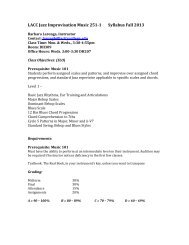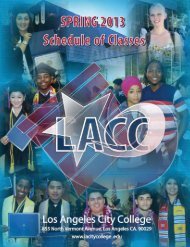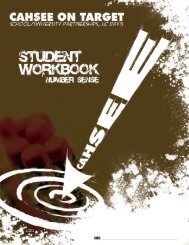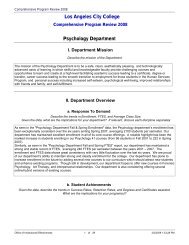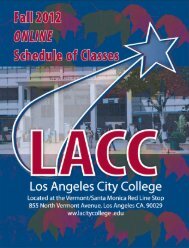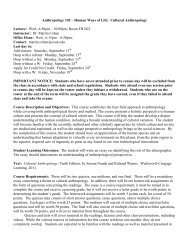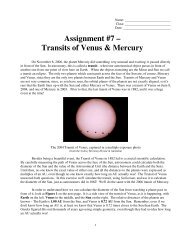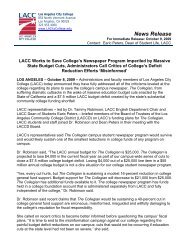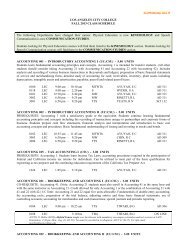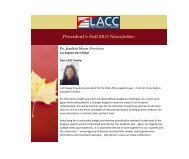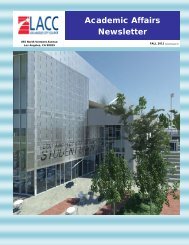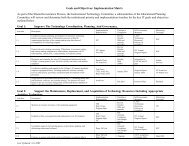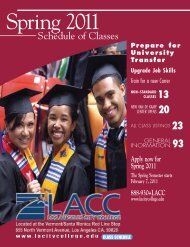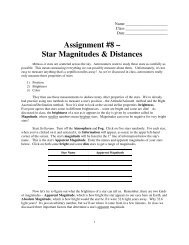LACC Vision & Mission Statements As Approved By - Los Angeles ...
LACC Vision & Mission Statements As Approved By - Los Angeles ...
LACC Vision & Mission Statements As Approved By - Los Angeles ...
Create successful ePaper yourself
Turn your PDF publications into a flip-book with our unique Google optimized e-Paper software.
LOS ANGELES CITY COLLEGE 80TH ANNIVERSARY CATALOG 2008-2009<br />
ASTRONOMY 5<br />
Fundamentals of <strong>As</strong>tronomy Laboratory<br />
1 UNIT – (UC:CSU)<br />
<strong>As</strong>tronomy: <strong>As</strong>tronomy 1<br />
<strong>As</strong>tronomy 5 laboratory course offers a presentation of the methods and<br />
techniques used by astronomers to determine the nature of the universe.<br />
This course uses some very basic mathematics, and can be taken by nonscience<br />
and/or science majors. When taken together with <strong>As</strong>tronomy 1 or<br />
<strong>As</strong>tronomy 10 or <strong>As</strong>tronomy 11, a student’s ‘science with a lab’ transfer and<br />
graduation requirement is met. Topics covered in <strong>As</strong>tronomy 5 include star<br />
names, asterisms and constellations, sky motion, planet motion, orbital<br />
motion, stellar brightness, stellar spectrum, crater formation, star clusters,<br />
galaxies and deep sky objects. An important part of the course involves<br />
working with and learning the operation of astronomical instruments and<br />
equipment including celestial globes, astrolabes, azimuth sundials,<br />
astronomical binoculars and computer controlled telescopes.<br />
ASTRONOMY 10<br />
The Solar System<br />
3 UNITS - (UC:CSU)<br />
Advisory: English 28/31 or concurrent enrollment in Learning Skills 1 or 7.<br />
This conceptual course surveys the solar system. Course topics include the<br />
Earth and Moon, the other 7 planets and their moons and rings, asteroids,<br />
comets, meteoroids, the Sun, plus the origin and structure of the solar system.<br />
There will also be some discussion of the design and workings of telescopes<br />
and other astronomical instruments. No college math preparation is needed!<br />
ASTRONOMY 11<br />
Stars, Galaxies, and the Universe<br />
3 UNITS - (UC:CSU)<br />
Advisory: English 28/31 or concurrent enrollment in Learning Skills 1 or 7.<br />
This conceptual course surveys the universe beyond the solar system.<br />
Topics covered include the properties of stars, stellar evolution, black holes,<br />
galaxies, the big bang, cosmology, and the possibility of extraterrestrial<br />
life. No college math preparation is needed!.<br />
PHYSICS 6<br />
General Physics I<br />
4 UNITS - (UC:CSU)<br />
Prerequisite: Completion of three years of high school math, including<br />
trigonometry, or Mathematics 240.<br />
Advisory: English 28/31 or equivalent.<br />
Lecture 3 hours. Laboratory and discussion 3 hours.<br />
This course is designed for majors in Health and Life Sciences, Architecture,<br />
and all those needing a one year course in college physics requiring<br />
trigonometry but not calculus (see also Physics 21). The principal topics are<br />
mechanics, heat and sound.<br />
PHYSICS 7<br />
General Physics II<br />
4 UNITS - (UC:CSU)<br />
Prerequisite: Physics 6 with a satisfactory grade or equivalent.<br />
Lecture 3 hours. Laboratory and discussion 3 hours.<br />
Physics 7 is the second of a two-semester, trigonometry based sequence<br />
of general physics courses. Topics covered include electricity and<br />
magnetism, optics, relativity and quantum theory, atomic and nuclear<br />
physics.<br />
- 174 -<br />
PHYSICS 11<br />
Introductory Physics<br />
4 UNITS - (UC:CSU)<br />
Prerequisite: Mathematics 115 and 120 with a satisfactory grade or equivalent.<br />
Advisory: English 28/31 or equivalent.<br />
Credit allowed for only one of Physics 11 or 12.<br />
Lecture 3 hours. Laboratory and demonstration 3 hours.<br />
This general introductory course with laboratory serves as the prerequisite<br />
for Physics 101, 6, 21, and for the health career programs. It is aimed at<br />
developing physical intuition, problem solving techniques and laboratory<br />
procedures. It is not open to students who have had a college course in<br />
physics. Those needing only one semester of laboratory science should<br />
consider enrolling in Physics 12 and 14.<br />
PHYSICS 12<br />
Physics Fundamentals<br />
3 UNITS - (UC:CSU)<br />
Open to all students. Advisory: English 28/31 or equivalent.<br />
Credit allowed for only one of Physics 12 and 11.<br />
A journey into the world of physics— its ideas, methods, personalities, and<br />
implications. A brief attempt to make some sense of the universe for all those<br />
who do not plan further work in physics. Credit for a laboratory science course<br />
may be earned through concurrent enrollment in Physics 14. Not open to<br />
students who have had a college course in physics.<br />
PHYSICS 14<br />
Physics 14 Laboratory<br />
1 UNIT - (UC:CSU)<br />
Co-requisite: Physics 12.<br />
Laboratory 3 hours.<br />
Advisory: English 21<br />
This introductory laboratory course in general physics provides the liberal<br />
arts student with laboratory experience which supplements the instruction<br />
given in Physics 12. Taken with or after Physics 12, it completes the units<br />
requirement for a Natural Science course with laboratory.<br />
PHYSICS 21<br />
General Physics I with Calculus<br />
4 UNITS - (UC:CSU)<br />
Prerequisite: Physics 11 with a satisfactory grade or high school physics.<br />
Co-requisite: Mathematics 261.<br />
Advisory: English 28/31 or equivalent.<br />
Lecture 3 hours. Laboratory 2 hours. Discussion 1 hour.<br />
Physics 21 is the first of a two-semester, calculus-based, sequence of general<br />
physics courses. (Physics 22 completes the sequence.) This sequence is<br />
recommended and designed for Pre-medical students, Life Science students<br />
and other students that require a two-semester, calculus based, sequence<br />
of physics courses. Topics covered in Physics 21 include mechanics, waves<br />
and fluids, with an emphasis on applications to the life sciences.<br />
PHYSICS 22<br />
General Physics II with Calculus<br />
4 UNITS - (UC:CSU)<br />
Prerequisites: Physics 21 with a satisfactory grade or equivalent.<br />
Co-requisite: Mathematics 262.<br />
Lecture 3 hours. Laboratory 2 hours. Discussion 1 hour.<br />
Physics 22 is the second of a two-semester, calculus-based, sequence of<br />
general physics courses. This sequence is recommended and designed for<br />
Pre-medical students, Life Science students and other students that require<br />
a two-semester, calculus based, sequence of physics courses. Topics<br />
covered in Physics 22 include thermodynamics, electricity and magnetism,<br />
optics, and atomic and nuclear physics.. There will be an emphasis on<br />
applications to the life sciences.



